HOK’s Kay Sargent has 30 years of experience helping companies optimize their global real estate portfolios and create innovative work environments. OfficeSpace Software asked her about the future of workplace design.
Excerpted from OfficeSpace Software:
Designing workplaces that will accommodate change:
“Organizations need to embrace the fact that 20 years ago, we might have designed a space once and let it sit for 10 years. If we do that today, the space will quickly be irrelevant. The speed of change is so fast and evolution is so quick that we need to embed flexibility. We need to create spaces that are agile and we need to be willing to go back to continually assess and determine what’s new with technology, in the business world, with the sharing economy and with evolving demographics that will impact our workplace. Then we have to be willing to adjust and tweak to accommodate those shifts.”
Technology and design considerations that are most important to create an agile work environment:
“There is going to be a real change in the next 10 years and I think the change is going to be with the Internet of Things, beacon technology and sensors. The car industry is a good example of what we should be striving for. You have a key for certain cars that you can put into the door and it automatically knows ‘okay, this is Kay and she likes this radio station, this temperature and her seat in this position’ and it automatically adjusts to me. It is cognitively and intuitively engineered to adjust to my preferences and to conform to my needs. Beacon technology, sensor technology and occupancy technology can give us much better information and data about how to use, design and adjust space. This exists for the temperature, lighting, air and music—we just need to leverage it more.”
Trends in workplace design:
“The biggest workplace trend we are seeing is variety, choice and giving people options. We are dealing with a wide variety of people—ethnically, gender and age groups. We are dealing with different workstyles and with introverts, extroverts. We are getting to a point where it’s about hiring smart people, empowering and giving them options and choices and letting them do what they do best.”
Valuing the cost of human capital:
“Real estate is cheap compared to people. Companies typically spend about 80 percent of their money on employees, human capital, about 10 percent on technology and about 10 percent on their real estate. If you mess up that 80 percent by designing spaces where people aren’t as productive, efficient, happy, comfortable or engaged, you will negatively impact the bottom line far more than whatever you might have saved by squeezing them into less space. We need to start thinking about employee engagement and human-centric design that allows people to function at higher levels.”
Understanding the workforce of the future:
“If you don’t know who you are planning for—and if we all agree that we are ultimately designing space for people—then you need to understand the workforce you are planning for. The Gen Zs are right behind the millennials and they are coming into the workplace in the next five years. The oldest Gen Z is about 15 now. We need to let the millennials develop their legacy and stop putting them under this microscope. We need to also start broadening our horizons and say ‘okay, what’s the next group and what are their issues?’. And we need to acknowledge that it’s about ALL people, not just one group.”
